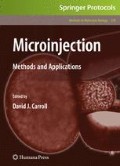Abstract
Bacteriophage φC31 inserts its genome into that of its host bacterium via the integrase enzyme which catalyzes recombination between a phage attachment site (attP) and a bacterial attachment site (attB). Integrase requires no accessory factors, has a high efficiency of recombination, and does not need perfect sequence fidelity for recognition and recombination between these attachment sites. These imperfect attachment sites, or pseudo-attachment sites, are present in many organisms and have been used to insert transgenes in a variety of species. Here we describe the φC31 integrase approach to make transgenic Xenopus laevis embryos.
Access this chapter
Tax calculation will be finalised at checkout
Purchases are for personal use only
References
Kroll K.L., Amaya E. (1996) Transgenic Xenopus embryos from sperm nuclear transplantations reveal FGF signaling requirements during gastrulation. Development 122, 3173–83.
Sparrow D.B., Latinkic B., Mohun T.J. (2000) A simplified method of generating transgenic Xenopus. Nucleic Acids Res. 28, E12.
Ogino H., McConnell W.B., Grainger R.M. (2006) Highly efficient transgenesis in Xenopus tropicalis using I-SceI meganuclease. Mech. Dev. 123, 103–13.
Pan F.C., Chen Y., Loeber J., Henningfeld K., Pieler T. (2006) I-SceI meganuclease-mediated transgenesis in Xenopus. Dev. Dyn. 235, 247–52.
Liu J., Jeppesen I., Nielsen K., Jensen T.G. (2006) Phi c31 integrase induces chromosomal aberrations in primary human fibroblasts. Gene Ther. 13, 1188–90.
Kuhstoss S., Rao R.N. (1991) Analysis of the integration function of the streptomycete bacteriophage phi C31. J Mol Biol. 222, 897–908.
Thyagarajan B., Olivares E.C., Hollis R.P., Ginsburg D.S., Calos M.P. (2001) Site-specific genomic integration in mammalian cells mediated by phage phiC31 integrase. Mol. & Cell. Biol. 21, 3926–34.
Thorpe H.M., Smith M.C. (1998) In vitro site-specific integration of bacteriophage DNA catalyzed by a recombinase of the resolvase/invertase family. Proc. Nat. Acad. Sci. USA 95, 5505–10.
Lutz K.A., Corneille S., Azhagiri A.K., Svab Z., Maliga P. (2004) A novel approach to plastid transformation utilizes the phiC31 phage integrase. Plant J. 37, 906–13.
Groth A.C., Olivares E.C., Thyagarajan B., Calos M.P. (2000) A phage integrase directs efficient site-specific integration in human cells. Proc. Nat. Acad. Sci. USA 97, 5995–6000.
Chalberg T.W., Genise H.L., Vollrath D., Calos M.P. (2005) phiC31 integrase confers genomic integration and long-term transgene expression in rat retina. Invest. Ophthalmol. Vis. Sci. 46, 2140–6.
Thomason L.C., Calendar R., Ow D.W. (2001) Gene insertion and replacement in Schizosaccharomyces pombe mediated by the Streptomyces bacteriophage phiC31 site-specific recombination system. Mol. Gen. & Genomics: MGG. 265, 1031–8.
Olivares E.C., Hollis R.P., Chalberg T.W., Meuse L., Kay M.A., Calos M.P. (2002) Site-specific genomic integration produces therapeutic Factor IX levels in mice. Nat. Biotechnol. 20, 1124–8.
Held P.K., Olivares E.C., Aguilar C.P., Finegold M., Calos M.P., Grompe M. (2005) In vivo correction of murine hereditary tyrosinemia type I by phiC31 integrase-mediated gene delivery. Mol. Ther. 11, 399–408.
Belteki G., Gertsenstein M., Ow D.W., Nagy A. (2003) Site-specific cassette exchange and germline transmission with mouse ES cells expressing phiC31 integrase. Nat. Biotechnol. 21, 321–4.
Keravala A., Portlock J.L., Nash J.A., Vitrant D.G., Robbins P.D., Calos M.P. (2006) PhiC31 integrase mediates integration in cultured synovial cells and enhances gene expression in rabbit joints. J. Gene Med. 8, 1008–17.
Ishikawa Y., Tanaka N., Murakami K., Uchiyama T., Kumaki S., Tsuchiya S., Kugoh H., Oshimura M., Calos M.P., Sugamura K. (2006) Phage phiC31 integrase-mediated genomic integration of the common cytokine receptor gamma chain in human T-cell lines. J. Gene Med. 8, 646–53.
Bertoni C., Jarrahian S., Wheeler T.M., Li Y., Olivares E.C., Calos M.P., Rando T.A. (2006) Enhancement of plasmid-mediated gene therapy for muscular dystrophy by directed plasmid integration. Proc. Natl. Acad. Sci. USA 103, 419–24.
Groth A.C., Fish M., Nusse R., Calos M.P. (2004) Construction of transgenic Drosophila by using the site-specific integrase from phage phiC31. Genetics 166, 1775–82.
Allen B.G., Weeks D.L. (2005) Transgenic Xenopus laevis embryos can be generated using phiC31 integrase. Nat. Methods 2, 897–8.
Kuhn E.J., Geyer P.K. (2003) Genomic insulators: connecting properties to mechanism. Curr. Opin. Cell Biol. 15, 259–65.
West A.G., Gaszner M., Felsenfeld G. (2002) Insulators: many functions, many mechanisms. Genes Dev. 16, 271–88.
Hollis R.P., Stoll S.M., Sclimenti C.R., Lin J., Chen-Tsai Y., Calos M.P. (2003) Phage integrases for the construction and manipulation of transgenic mammals. Reprod. Biol. Endocrinol. 1, 79.
Sive H.L., Grainger R.M., Harland R.M. (2000) Early Development of Xenopus laevi: A Laboratory Manual. Cold Spring Harbor Laboratory Press. Cold Spring Harbor, N.Y.
Acknowledgements
We would like to thank Professor Michele Calos for providing the pET11phiC31poly(A) plasmid, Professor Gary Felsenfeld for providing the HS4 insulator sequences, and Paul Kreig for providing the gamma crystallin lens promoter. This work was supported by funding from the NIH (GM069944 and DC007481). Bryan Allen is a student in the Medical Scientist Training Program at the Roy J. and Lucille A Carver College of Medicine, University of Iowa.
Author information
Authors and Affiliations
Editor information
Editors and Affiliations
Rights and permissions
Copyright information
© 2009 Humana Press, a part of Springer Science+Business Media, LLC
About this protocol
Cite this protocol
Allen, B.G., Weeks, D.L. (2009). Bacteriophage φC31 Integrase Mediated Transgenesis in Xenopus laevis for Protein Expression at Endogenous Levels. In: Carroll, D. (eds) Microinjection. Methods in Molecular Biology, vol 518. Humana Press. https://doi.org/10.1007/978-1-59745-202-1_9
Download citation
DOI: https://doi.org/10.1007/978-1-59745-202-1_9
Published:
Publisher Name: Humana Press
Print ISBN: 978-1-58829-884-3
Online ISBN: 978-1-59745-202-1
eBook Packages: Springer Protocols

